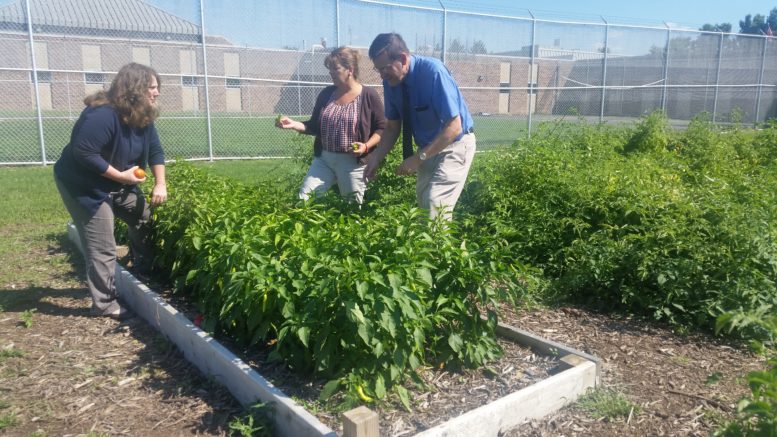By JAN LARSON McLAUGHLIN
BG Independent News
The community service garden being grown by juvenile offenders is helping kids clean up their lives as they get their hands a little dirty.
The Wood County Juvenile Court garden, now in its fifth year, is harvesting benefits for the youth, local food pantries and families in need of fresh vegetables. As of last week, this year’s harvest was up to 3,140 tomatoes, 2,000 banana peppers, 750 mini bell peppers, 58 zucchini and 35 squash.
But more importantly, the community service work garden is planting seeds in the youth working it.
“It’s the ‘teach a kid to fish idea,’” said Ronda Downard, who cultivated the gardening idea with Lora Graves, both co-directors of the juvenile probation department.
“It’s educating them as they are doing something for the community,” Graves said.
For years, the juvenile court’s community service program offered offenders a chance to put in their hours by picking up trash. But the value of that was pretty limited, said Wood County Juvenile Court Judge Dave Woessner.
“This has a benefit that reaches out to a lot of learning,” the judge said of the garden.
So every Saturday, spring through early fall, juvenile offenders who were ordered to pay fines, court costs, or restitution, show up at the garden next to the juvenile court and detention center, to put in their hours.
These are kids in trouble for offenses like truancy, unruly behavior, theft, underage consumption, drug offenses and delinquency. More than 80 youth have worked on the 40-foot by 32-foot garden so far this year.
“A lot of these kids had never been in a garden,” Downard said.
“They had no idea when they saw the food, where they came from,” Graves said.
But the youth quickly picked up skills and voiced their preference for gardening over picking up trash.
“They are a lot happier doing it than trash work ,” Graves said. “Even when we had them shoveling manure, they were happy.”
As the season progresses, the youth feel success being able to reap the rewards from their work.
“They really enjoy just being able to see it grow and being a part of it,” Graves said.
The harvest is given away to local food pantries or churches, with the youth being allowed to taste the results of their efforts. “They have been allowed to sample it,” Downard said.
The vegetables were first donated to the Bowling Green Christian Food Pantry. But the ample harvest overwhelmed the pantry.
“They asked us to stop because we had literally overstocked their shelves,” Downard said.
So next, more than 1,000 tomatoes, squash and peppers went to St. Mark’s Lutheran Church to be used for a community meal. Some of the harvest was also given to First United Methodist Church to put out for people to pick up when they attend the weekly Martha’s Kitchen meal on Fridays.
The youth help deliver the vegetables to the food pantry.
“I think it’s good for them to go to deliver it too,” Downard said. “Not everybody gets to shop at Kroger. There’s a line of people waiting at the pantries. That’s good for them to see. Not everyone is as fortunate as them.”
To make the garden a success, several donations were made by the community. OSU Extension experts advised the juvenile court staff and youth on gardening techniques. Two court staff members stopped at the construction site for Kokosing, which is doing work on Interstate 75 to ask for clean dirt. The construction company delivered two dump trucks full. And Penta Career Center students built raised planter beds.
Thomas Mack and Plants for All Things donated many of the plants, Sandra Tebbe and the Project HOPE Equine Therapy donated horse manure, and the Wood County Solid Waste Management District and Wood County Landfill donated mulch.
The harvest this year has been better than the previous four years combined.
“It really is an outstanding success,” Woessner said. And the harvest is far more than tomatoes and peppers – but juveniles who learn something about cleaning up their lives as they get their hands a little dirty.

